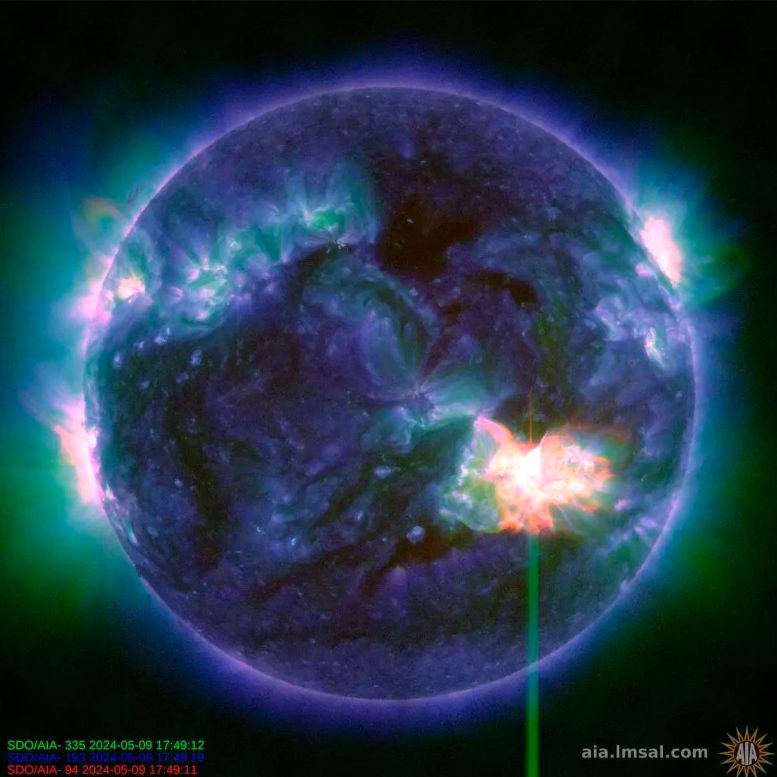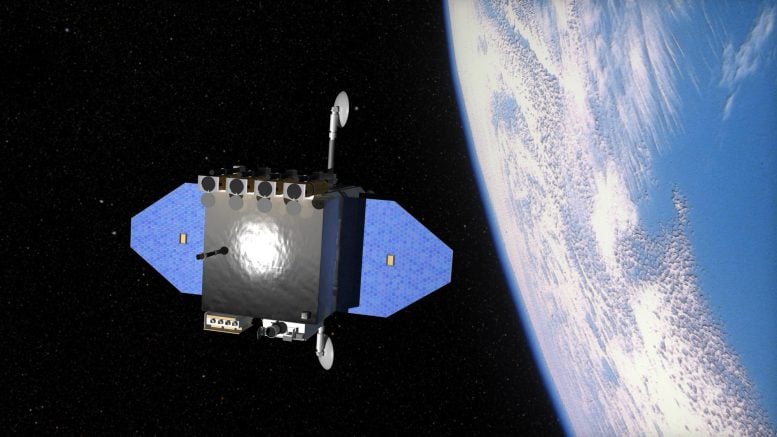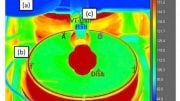
NASA’s Solar Dynamics Observatory captured this image of a solar flare – as seen in the bright flash in the lower right – on May 9, 2024. The composite image combines three wavelengths of extreme ultraviolet light that highlight the extremely hot material in flares and which is colorized in green, blue, and red. Credit: NASA/SDO
On May 9, 2024, NASA’s Solar Dynamics Observatory detected a significant solar flare that peaked at 1:44 p.m. ET. This observatory is dedicated to continuously monitoring the Sun, and it successfully captured an image of this event. This follows the release of X-class solar flares on both May 7 and May 8.
This flare is classified as an X1.1 flare. X-class denotes the most intense flares, while the number provides more information about its strength.
Solar Flares
Solar flares are intense bursts of radiation emanating from the release of magnetic energy associated with sunspots. These flares are one of the most powerful forms of solar activity and are primarily composed of photons, ranging from radio waves to gamma rays. They occur in the Sun’s atmosphere, lighting up as bright areas on the sun that can last from minutes to hours.
The classification of solar flares is based on their brightness in the x-ray wavelengths. The classes are labeled as A, B, C, M, and X, with A being the weakest and X being the strongest. Each class has a tenfold increase in energy output compared to the preceding one. Within each class, there is a finer scale from 1 to 9 that quantifies more precisely the strength of the flare. For instance, an X1 flare is ten times as powerful as an M1 flare but is considerably weaker than an X9 flare. This system helps scientists and relevant authorities gauge potential impacts on Earth, such as disruptions in communication and navigation systems, and prepare appropriate responses.
NASA’s Solar Dynamics Observatory
NASA’s Solar Dynamics Observatory (SDO) is a mission launched in February 2010 as part of the Living With a Star (LWS) program. The primary goal of the SDO is to understand the influence of the Sun on the Earth and near-Earth space by studying the solar atmosphere on small scales of space and time and in many wavelengths simultaneously. SDO has been instrumental in providing detailed data about the Sun’s activity and its components such as solar flares, coronal mass ejections (CMEs), and magnetic fields.
Equipped with a suite of instruments, SDO captures high-resolution images of the Sun in 13 different wavelengths every few seconds. This includes capturing images in ultraviolet, extreme ultraviolet, and visible light spectrums, which help in observing the solar atmosphere with incredible detail. SDO’s data is crucial for understanding the solar variations that influence life on Earth and the technological systems in space. The observatory helps scientists gain insights into the complex solar dynamics and supports efforts to predict solar weather with greater accuracy.










Be the first to comment on "Solar Stormwatch: NASA Catches Intense X1.1 Flare in Action"